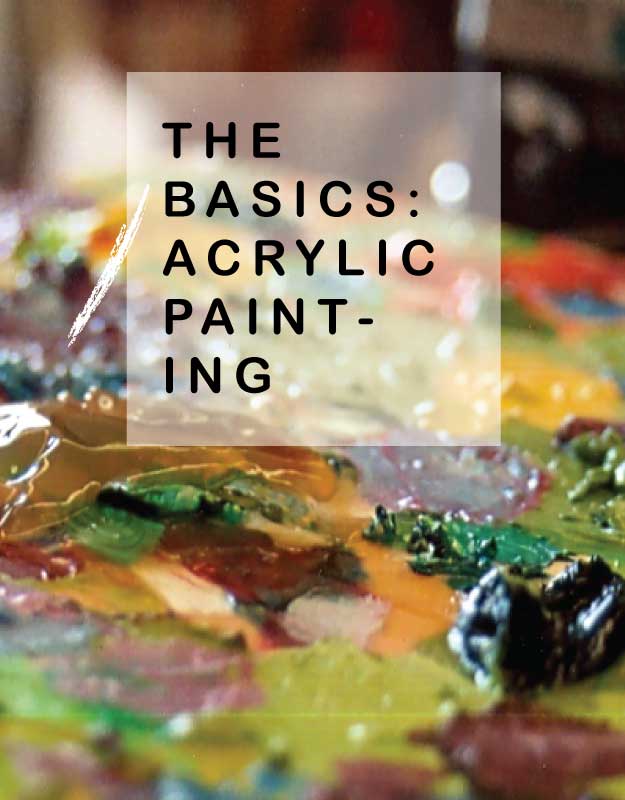There’s something about painting. I don’t know if it’s the movement of the brush, or the fact that it forces you to slow down, and really observe the facets of our daily lives as you paint. Whether its a mountainous landscape, a bowl of fresh fruit, or a favorite tree, I find that my appreciation for design and detail is heightened when I slow down and extract each detail, layer upon layer, finding with each additional stroke more beauty is created. While spending some free time this weekend, I broke out some of my art supplies and taught a friend how to paint. It was so much fun revisiting this hobby and sharing it with someone else. Today, I thought I’d share with you a few of my tips and tricks to get you started. Let the art class begin!
Supplies:
- Acrylic paint (I use a semi-professional grade, in the primary colors, black, white, and burnt sienna)
- Synthetic brushes (when painting with acrylics, I use synthetic hair brushes in the following sizes: a large brush, then two smaller brushes, one with a rounded edge, the other with a chiseled edge)
- Wax paper and a plate (this will be your palette, you want something non-porous and easy cleanup so this will do the trick)
- Cup of Water
- Old washcloth
- Pencil
- Wrapped canvas board
Directions:
Step one: Pick a subject. Using your pencil, lay in a simple outline. This mark should be light and almost-feather like. (As you begin painting, I suggest working from life.)
Step two: Assemble your palette. Acrylics dry rather quickly. This can make them somewhat difficult to work with. Because of this, I add a little bit of paint at a time to the palette to create less waste. For beginners, achieving the colors you want to create can be a task. Don’t worry! Color theory can be challenging to even the most experienced artist. Remember the color wheel from elementary school art class? Begin there. Looking to make orange? Red and yellow. Purple? Red and blue. Green? Yellow and blue. Brown? All the primary colors mixed together. Gray? Brown with blue. I never use colors strictly out of the bottle or in their basic mixed state. Colors straight from the bottle don’t really look like any colors I see. I look at them as starting points, that need to be customized. I may lighten the colors with white or deepen them with a touch of brown. At this point, you will want to choose a few colors to include in your painting. This limits your color scheme and adds cohesion to the finished product. My last painting stayed within the blue and green family. The previous painting used burnt sienna, yellow ochre and teal as the main colors. Pick a few colors and allow these to be the “main-players” in your painting.
Tip: I never use black as it makes colors muddy and doesn’t exist as an organic color outside of the pupils in someone’s eye.
Tip: Do you find that your colors don’t have the pop you might desire? Do they seem to get lost in a previous color on the canvas? Add a bit of white. This will create a subtle change in color, but will add opacity and luminosity to the hue, allowing it to remain visible to the eye.
Step three: Lay in your background, your midground, and your foreground. By layering your colors there will be a greater vibrancy in the end product.
Step four: Identify where your light source is coming from. Begin to lay in the darks, medium shades, and highlights to add definition and shape to your subject.
Step five: You’re doing great! Keep on going! This is where I add in my details. Here’s where I mentally focus on line over shape. Lay in the small details that will make this piece shine. Maybe it’s the glimmer on the movement of water, maybe its the texture of the orange peel in a still life, or the clouds in the sky.
Step six: Push your values. Often times after laying in details, I realize how safe I played it when it came to step four. Add true dark tones, various shades, and see your piece come to life.
Tip: Get squinty. I always can tell if I have pushed my values enough, if I squint and the subject is clear. If I’m wanting to push my values and don’t know where to begin, I look at my “from-life” object and identify where the darkest values and highlights are. This gives me a starting point and helps me pinpoint exactly where the lightsource is.
Step seven: Add any fine details. Each of my paintings typically takes around 10-20 hours to complete. I usually break this up into multiple sittings.
Step eight: You’re done! Enjoy your masterpiece, you Rembrandt you.
Stay tuned: later this week I share my latest creation- a piece of acrylic abstract art.

